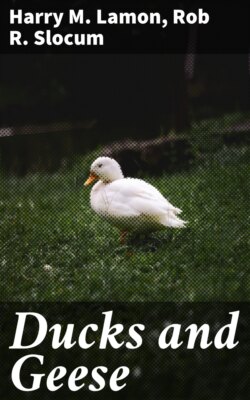Читать книгу Ducks and Geese - Rob R. Slocum - Страница 13
На сайте Литреса книга снята с продажи.
Considerations in Making the Mating[1]
ОглавлениеSince ducks are kept for different purposes there will of course be certain fundamental differences in the different classes in the selection of the individuals to make up the mating. Whatever the purpose, however, the first consideration in selecting the breeders must be to secure those which possess excellent vigor and general health and which meet insofar as possible the standard requirements for size. Where the Call duck and the Black East India are concerned the selection for size must be for smallness since that is a characteristic greatly desired. In the other breeds the selection for size must be to see that they come up to the standard weights for the particular breed in question. As in other classes of fowls the condition and cleanliness of the plumage and the general appearance and actions of the birds are good indications of their health and thriftiness. A bright eye is likewise a valuable indication of good health while a watery eye is usually a sign of weakness. It is necessary to guard against birds which show any tendency toward crooked or roach back, hump back, crooked tails, or twisted wings. Since all breeds of ducks should have clean or unfeathered legs it is likewise necessary to guard against any breeders which show down on the shanks or between the toes as this sometimes occurs.
[1] For a more detailed discussion of the principles of breeding as applied to chickens and which is equally applicable to ducks, the reader is referred to "The Mating and Breeding of Poultry" by Harry M. Lamon and Rob R. Slocum, published by the Orange Judd Publishing Company, New York City.
In selecting the mating for any one of the meat breeds use birds which have good length, width and depth of body so that they will have plenty of meat carrying capacity. For breeders of market ducks, birds which are active, well matured and which are not extreme in size for the breed are preferable as the fertility is likely to run better than with the extremely large birds. Where birds are bred for exhibition purposes, it frequently happens that it is desirable to use large breeders and to hold them for breeding purposes as long as they are in good breeding condition. Where this is the case it becomes necessary to mate a smaller number of females to a drake than would be the case with smaller and younger breeders. Where old birds are used as breeders better results will be secured by mating old ducks to a young drake or vice versa than by mating together old birds of both sexes. While ducks of any of the meat breeds are kept primarily for meat production, it is essential that the egg production be good throughout the breeding season in order to raise as many ducklings and secure as great a profit as possible. Selection of the females as breeders should be made therefore on the basis of good egg production as well as good meat type if the conditions under which the ducks are kept are such as to make it possible to check this in any manner.
In selecting the mating in the Runner breed it is necessary to keep in mind that the general type of body is quite different from that of the meat breeds, being much slimmer and much more upright in body carriage. For this mating select thrifty, healthy birds and those which are active. Some breeders trapnest their Runner ducks or have some other means of checking up the better layers. As in chickens, it is of course desirable to use these better layers as breeders since the purpose in keeping this kind of duck is primarily egg production.
In selecting the mating in the Call and East India breeds it is necessary to use the smaller ducks since the object here is to keep the size small. In addition, with these breeds or with any other breeds kept and bred primarily for fancy or exhibition purposes, it is necessary to conform just as closely as possible to the standard requirements[2] both insofar as size and type are concerned, and also with respect to color.
[2] For a complete and official description and list of disqualifications of the standard breeds and varieties of ducks, the reader is referred to the American Standard of Perfection published by the American Poultry Association, and obtained by Orange Judd Publishing Company, New York, N. Y.
